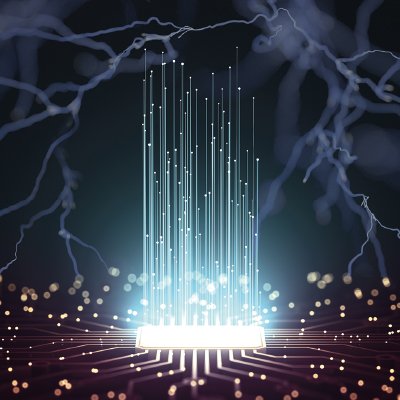
Neuromorphic Computing and Engineering
@IOPneuromorphic
Followers
2K
Following
466
Media
396
Statuses
556
Get the latest #Neuromorphic Research, Publishing Tips, News, And Offers conveniently delivered to your inbox. 👉 Sign-up today: https://t.co/sVnSbl0vpY
Bristol, UK
Joined November 2020
Dear Follower, X will no longer be our primary platform for sharing news. We would love to connect with you on BlueSky via @ioppublishing.bsky.social and Threads via @iop.publishing For updates and insights please come and find us on these platforms. #NewBeginnings #BlueSky
0
1
2
Researchers from @engineering_UT introduce an analog spiking neuron that utilizes time-domain information to construct a spiking neural network (SNN) for a hardware-friendly physical reservoir computing on a CMOS platform in https://t.co/RXumcScnyh
@UTokyo_News_en @JST_Kisokenkyu
0
0
3
Researchers from @ntua fabricated a free memory forming device consisting of a MoS2 monolayer with dimensions of ∼100 μm, decorated with ∼3 nm diameter Pt nanoparticles, demonstrating synaptic plasticity and neuronal coding schemes in experiments. https://t.co/ZYJKmmKmTM
0
0
1
Our latest Rising Star is Suma George Cardwell, who with colleagues at @SandiaLabs presents work that aims to incorporate dendrites for "compute-on-wire" in neuromorphic architectures. Read the paper at https://t.co/0u7iosSSRz, see the whole collection at https://t.co/z9Xo2SJClY
0
0
3
Part of https://t.co/P2fhZo93Up, this Perspective article from @westernsydneyu, @UniofHerts and @CUBoulder takes a look at machine olfaction, finding that applying neuromorphic principles may improve response time and task performance in robotic olfaction: https://t.co/pdsiUqjMtE
0
1
2
Part of https://t.co/V9EKtgfV5U, this paper from @IITKanpur proposes a novel, highly scalable, compact, energy-efficient, and reconfigurable logic-in-memory implementation by exploiting the drain-erase scheme utilizing a single ferroelectric FDSOI FET. https://t.co/mVa6zbPgl9
0
0
2
Part of https://t.co/V9EKtgfV5U, here @Mattias_Borg and colleagues from @lunduniversity and @ericssonlabs evaluate the viability of FTJ memristors as compute units for analog in-memory computing (AIMC), revealing benefits alongside intrinsic challenges: https://t.co/JmC0r2iox0
0
0
1
Part of https://t.co/P2fhZo93Up, this paper from @UTKnoxville @EECS_UTK
https://t.co/SmpTJPI6ps presents cutting-edge neuromorphic technology beating a retro Atari 2600 at Pong. What's your high score? https://t.co/dzq2pJoLWI
0
0
3
Part of https://t.co/P2fhZo93Up, this paper from @TU_Muenchen presents a novel spiking neuron model for signal processing of frequency-modulated continuous wave radars that outperforms the state-of-the-art spectrum analysis algorithms in many respects https://t.co/5mYFhzfQyj
0
0
2
Our latest Rising Star is Chiara De Luca (Institute of Neuroinformatics, @uzh_en @eth_en), who with @FFilippoCCosta proposes an encoding framework inspired by biological principles, using at most one spike per neuron, for low-power, low-latency processing: https://t.co/8MhE7drzER
0
0
2
#TUBraunschweig researchers with colleagues at @amsOSRAM & elsewhere in Germany and Switzerland present a novel approach for the implementation of a mixed photonic/electronic neural network using gallium nitride based microLEDs as an efficient key element https://t.co/zGtm8bmPJC
0
0
0
Part of https://t.co/P2fhZo93Up, this paper from Cristian Axenie and TH Nürnberg colleagues proposes a novel neuromorphic edge fusion of SNNs and event-based expectation maximization for the detection and tracking of pedestrians and cyclists. Read more at: https://t.co/V4ITPmBPKR
0
0
0
Part of https://t.co/V9EKtgfV5U, this paper from @univgroningen proposes Fused-MemBrain, inspired by Golgi's theory modeling the brain as a syncytial continuum, with a memristive network interfaced with spiking neural networks. Read more at: https://t.co/7KrAYOBGCF
0
0
0
Lei Deng (@Tsinghua_Uni) is our latest Rising Star. With colleagues at @CBICR_THU and Taiyuan University of Technology he explores the emulation of finite state machines (FSMs) with neural networks, proposing discrete-time spiking recurrent neural networks https://t.co/GwpmyVEkuc
0
0
0
As part of https://t.co/FHSf1eoKW3,
@HerbozoFernando, @JHuang_ai, @OmidKavehei & colleagues from @Sydney_Uni investigate biologically plausible algorithms, specifically emphasizing time-domain inputs with low computational overhead, to monitor EEG signals: https://t.co/updwcwRZpr
0
1
2
Sofie J Studholme, Joshua B Mallinson, Jamie K Steel & @cluster_guy (@UCNZ) demonstrate a route to experimental implementation of an integer factorization algorithm in percolating networks of nanoparticles (PNNs), which have a brain-like network structure: https://t.co/YkjTagHClA
0
0
0
Congratulations to all recipients of our Outstanding Reviewer Awards! 🎉Your commitment, timeliness, quality, & quantity of reports is celebrated across our journals. Let's celebrate all #PeerReview contributions that uphold #ResearchIntegrity Discover 👉 https://t.co/nPKCX94ntK
0
0
1
Researchers from @jkulinz provide a mathematical framework that shows that the information encoding mechanisms of Threshold-Based Representation based on LIF and Send-on-Delta distinguish by maximal sparsity while meeting certain approximation conditions. https://t.co/UymDDvGYzm
0
0
1
Part of https://t.co/yEoOXhfYED, this paper from Michael Stuck, @XingyunWang4 & @neuronaud (@uOttawaCMM, @uOttawaBMRI) extends burst-dependent learning (Burstprop) to address more complex tasks with hundreds of neurons: https://t.co/5tQtIjnSBU
0
1
5
Part of https://t.co/sQwqKLix9O, this Perspective article from Jiyong Woo (@knustory) and colleagues investigates gate-controlled ion-transport primarily in electrolytes for electrochemical random-access memory (ECRAM) for three-terminal synaptic devices: https://t.co/nbp75OLRS7
0
0
1
